- Home
- Stephen Baxter
Space Page 5
Space Read online
Page 5
The next speaker impressed Malenfant rather more. She was a geologist from Caltech called Carole Lerner – no older than thirty, spiky, argumentative. She had tried to come up with a new answer to the conundrum of the arrival of the Gaijin. Maybe there had been no sign of the Gaijin before, said Lerner, because they had only recently evolved – and not among the stars, but where they had been found, in the asteroid belt itself.
There had been suggestions for some decades that life could get a foothold in comets – perhaps in pockets of liquid water, drenched with the organic compounds that laced cometary interiors – and, of course, some asteroids were believed to be burned-out comets, or at least to have a comparable composition to comets. The coincidence of the emergence of a spacefaring alien race in the asteroids now, just as we reached a similar state, might be explained by a convergence of timescales. Perhaps it simply took this long, a few billion years, for life to crawl its way from the ponds to the stars, no matter where it originated.
It was a nice hypothesis, Malenfant reflected, but he judged that the coincidence of timescales was surely too neat to be convincing. Still, this was the first speaker Malenfant had heard at the conference who had attempted to address the deeper issues which obsessed the likes of Nemoto. He glanced at his softscreen, seeking presenters’ bio details.
Lerner’s general specialism was the volcanic history of the planet Venus. Malenfant wasn’t surprised to learn she was having trouble finding funding to continue her work. One side-effect of the arrival of the Gaijin had been a decline of interest in the sciences. It seemed to be generally assumed that the Gaijin would eventually hand over the answers to any questions humans could possibly pose; so why spend time – and, more significantly, money – seeking out answers now? No genuine scientist Malenfant had ever met would have been satisfied with such passivity, of course; it seemed to him this Carole Lerner might be consumed with exactly that impatience.
The next paper, given by a heavy-set academic from the SETI Institute, turned out to have his own name in the title: ‘The Nemoto – Malenfant Contact – An Example of How Not to Do It’.
Maura Della sat back to listen with an expression of intense enjoyment.
The presentation was based on a bureaucratic protocol devised to cover the event of alien contact. The protocol was first worked out by NASA in the 1990s, and then, after the cancellation of government funding for SETI and the NASA project’s take-over by private institutions, developed further by the UN and national governments.
Malenfant – as one of only two people in all history to have been placed in the situation covered by the protocol – had never bothered to read it. He wasn’t surprised to learn now that it was top-down, officious and almost comically foolish in its optimism that central control could be maintained:
‘After concluding that the discovery appears to be credible evidence of extraterrestrial intelligence, and after informing other parties to this declaration, the discoverer should inform observers throughout the world through the Central Bureau for Astronomical Telegrams of the International Astronomical Union, and should inform the Secretary General of the United Nations in accordance with Article XI of the Treaty on Principles Governing the Activities of States in the Exploration and Use of Outer Space, Including the Moon and Other Bodies. Because of their demonstrated interest in and expertise concerning the question of the existence of extraterrestrial intelligence, the discoverer should simultaneously inform the following international institutions of the discovery and should provide them with all pertinent data and recorded information concerning the evidence: the International Telecommunication Union, the Committee on Space Research, of the International Council of Scientific Unions, the International Astronautical Federation, the International Academy of Astronautics, the International Institute of Space Law, Commission 51 of the International Astronomical Union and Commission J of the International Radio Science Union …’
Malenfant and Nemoto, by comparison, had gone straight on the talk shows.
Playfully, Maura slapped Malenfant’s wrist. ‘Naughty, naughty. All those Commissions you skipped. You made a lot of enemies there.’
‘But,’ he said, ‘I did get to sleep in the Lincoln Bedroom at the White House. You know, this guy makes it sound as if he’d rather we hadn’t made the discovery at all, rather than making it the wrong way.’
‘Human nature, Malenfant. You took away his toy.’
Now the speaker opened the floor for comments.
The discussion soon turned to how the situation should be managed from here. There were plenty of calls for behavioural scientists to study ways in which the public response to the news could be somehow anticipated and controlled, for research into popular public images of Eeties, discussion of analogies with the response to missions like Apollo to the Moon and Viking to Mars, and suggestions that SETI proponents should make use of media like webcasts, games and music to present SETI and Eetie themes ‘responsibly’.
Maura pulled an elaborate face. ‘Don’t these people realize the cat is already out of the bag? You can’t control the public’s access to information any more – and you certainly can’t control their response. Nor should you try, in my opinion.’
At last the speaker cleared off the stage, and Malenfant’s spirits lifted a little. As an engineer, he knew that a bucket-load of philosophical principles wasn’t worth a grain of good hard fact. And that was why the next item, by Frank Paulis, was a breath of fresh air. After all, it was Paulis, with his money and his initiative, who was actually going out there to look.
Paulis’s images of his en-route spacecraft, the Bruno, showed a gangly, glittering dragonfly of solar-cell panels and gauzy antennae and sensors mounted on long booms, surrounded by a swarm of microsats devoted to fly-around inspections and repairs.
The launch had been uneventful, the first years of the long flight enlivened only by the usual hardware glitches and nail-biting techie dramas. It struck Malenfant as remarkable how little space technology seemed to have progressed in seventy years since the first Sputnik; the design of the Bruno would probably have been recognizable, give or take a few sapphire-based quantum chips, to Wernher von Braun. But flying in space had always been a conservative business; if you had only one shot, you wanted your ship to work, not to serve as the test bed for new gadgets and ideas.
Anyhow, the Bruno had survived its man-made crises. The ship was still a year away from its rendezvous with what appeared to be the primary construction site – or colony, or nest – of the Gaijin. The asteroid belt was a broad lane of rubble; already the probe had encountered a number of those dusty wanderers, never visited before or seen in close-up. But – Paulis promised, standing before slide after slide of coal-dark, anonymous rocks – the best was yet to come. For, in the darkness, the Gaijin awaited.
After a morning of such thin gruel, Malenfant retreated to his hotel room.
He travelled light these days: just bathroom stuff, a couple of self-cleaning suits and sets of underwear, a softscreen that was all he needed to connect him to the rest of the species – and a single ornament, a piece of unbelievably ancient rock from the far side of the Moon, carved into an exquisite fox god. He had become minimal. The time he spent on the Japanese Moon, he supposed, had changed him, no doubt for the better.
He spent a half hour watching heavily filtered and interpreted news on his softscreen. He needed to know what was going on, but he was too old to have any patience with the evanescent buzz of instant commentaries.
A corner of his softscreen rippled with light: an incoming message.
It was Nemoto. It was the first time she’d contacted Malenfant in years.
‘Nemoto! Where are you?’
There was a delay of a few seconds before her reply came back, her face creasing into a thin smile. That could place her on the Moon. But the delay could be a fake …
‘You should know better than to ask me that, Malenfant.’
‘Yeah. Sorry.’
; She was still under forty, but she wasn’t ageing well, he thought. Her hair remained thick and jet black, but her oval face had shed its prettiness: grown angular, the bones showing, her eyes dark and sunken with suspicion. Her voice, from the softscreen’s tiny speakers, was an insect whisper. ‘You are enjoying the conference?’
‘Not much.’ He shared with her his gripe over too many philosophers.
‘But there are worse fools. Here is some more philosophy for you. “This is the way I think the world will end – with general giggling by all the witty heads, who think it is a joke.” Kierkegaard.’
‘He got it right.’ Whoever he was.
‘And philosophy can sometimes guide us, Malenfant.’
‘For instance –’
‘For instance, the notion of equilibrium …’
It was like resuming a conversation they had pursued, on and off, for nine years; a slow teasing-out of the koan.
After their notoriety following the announcement of the aliens in the belt, Nemoto had recoiled completely. She’d refused all offers of public appearances, had quit her job, had turned down offers of research positions from a dozen of the world’s most prestigious universities and corporations, and had effectively disappeared. All this while Malenfant had slogged around the public circuit with diminishing enthusiasm, enduring the brickbats and bouquets that came from his sliver of fame. She had been an Armstrong, he sometimes thought wryly, to his own Aldrin.
But she was continuing her researches – though what her purpose was, and where her money was coming from, he couldn’t have said.
She didn’t like the Gaijin, though. That much was obvious.
She said softly, ‘We imagined only two possible equilibrium states: no aliens, or aliens everywhere. We have diagnosed this moment, the moment of first contact, as a transition between equilibriums, brief and therefore unlikely for us to be living through. But what if that’s wrong? What if this is the true state of equilibrium?’
Malenfant frowned. ‘I don’t get it. Contact changes everything. How can a change be described as an equilibrium?’
‘If it happens more than once. Over and over and over. In that case it’s no coincidence that I happen to be alive, here and now, to witness this. It’s no coincidence that we happen to have a technical culture capable of detecting the signals, even initiating contact, of a sort, just at this moment. Because this isn’t unique.’
‘You’re saying this happened before? That others have been here? Then where did they go?’
‘I can’t think of any answers that don’t scare me, Malenfant.’
He studied her. Her eyes were almost invisible, her face an expressionless mask. The background was dark, anonymous, no doubt scrambled beyond the reach of image enhancement routines.
He considered what to say. You’re spending too much time alone. You need to get out more. But he was scarcely a friend to this strange, obsessive woman. ‘You’ve spent a lot of time thinking about this, haven’t you?’
She seemed offended. ‘This is the destiny of the species.’
He sighed. ‘What is it you called me about, Nemoto?’
‘To warn you,’ she said. ‘It isn’t quite true that we are waiting on Frank Paulis and his space probe for new data. There are two items of interest. First, a fresh interpretation. I’ve been able to deduce patterns from the infrared signature of the Gaijin’s activity in the belt. I believe I have determined their pattern of propagation.’
Her face disappeared, to be replaced by the virtual display of the type she’d first shown him in the silence of the Moon. It was a ring of glistening crimson droplets, slowly orbiting: the asteroid belt, complete with dark Kirkwood gaps. And there was the gap with the one-to-three resonance with Jupiter, with its string of rubies, enigmatic, brilliant.
‘Watch, Malenfant …’
Malenfant bent close to the screen and studied the little beads of light. The images cycled with small vector arrows, which showed velocity and acceleration. The rubies weren’t in simple orbits about the sun, he saw; they seemed to be spreading around the belt, some of them actually moving retrograde, against the motion of the rest of the belt.
The motion was intriguing.
Nemoto said, ‘Imagine the arrows projected backwards.’
‘Ah,’ Malenfant said. ‘Yes. They might converge.’
Nemoto cut in a routine to extrapolate back from the Gaijin sites’ velocity vectors. ‘This is rough and ready,’ she admitted. ‘I had to make a lot of assumptions about how the objects’ trajectories had deviated from simple orbits through the sun’s gravitational field. But it did not take long before I found an answer.’
The projected paths arced out of the asteroid belt – out, away from the sun, into the deeper darkness, before converging.
Malenfant tapped the screen. ‘You found it. The prime radiant. Where these probes, or factories, or whatever the hell they are, are emanating from.’
Nemoto said, ‘It is one point four times ten to power fourteen metres from the sun. That is –’
‘About a thousand astronomical units out.’ A thousand times as far as Earth from the sun. ‘Somewhere in the direction of Virgo … But why there?’
‘I do not know. I need more data, more work.’
‘And your second item?’
She eyed him. ‘You are meeting Maura Della. Ask her about Rigil Kent.’
Rigil Kent. Also known as Alpha Centauri, nearest star system to the sun, four light years away.
‘Nemoto –’
But the softscreen had already filled up with the everyday froth of the online news channels; Nemoto had receded into darkness.
He was taken to lunch by former Congresswoman Della.
After lunch they strolled around the conference hall, glancing at poster presentations and the fringe sessions. Malenfant felt uncomfortable being out in public like this.
‘I wouldn’t be too concerned,’ Maura said. ‘Not here; you have to be afraid of the ones who stay at home polishing the telescope sights on their rifles.’
‘Not funny, Maura.’
‘Perhaps not. Sorry.’
She hadn’t said a significant word during lunch; now he couldn’t contain himself any more. ‘Rigil Kent,’ he said.
She slowed to a halt. Her voice low, she said, ‘You spoiled my surprise. I should have known you’d find out.’
‘What’s going on, Maura?’
For answer she took him to a small, over-priced coffee bar. On a handheld softscreen she showed him images of the great radio telescope at Arecibo, various microwave satellites, activity in the Main Bay at JPL: arcs of consoles, young, excited engineers on roller chairs, information flickering over screens before them.
‘Malenfant, we’ve picked up a signal. From Alpha Centauri.’
‘What – how –’
She pressed a finger to his lips.
As it turned out – though this bit of news had been Maura’s true motive for inviting him here – there was little more to tell. Maura had gotten the news from her contacts in the government. The signal was faint, first picked up by an orbital microwave satellite. But it was nothing like the neatly structured Lincos signals humans had been sending to the asteroid belt. It was heavily compressed, a mush of apparently incoherent noise, with only evanescent hints of structure – much what Earth might have sounded like, from four light years away.
‘Or it may be an efficient signal,’ Malenfant said hoarsely. ‘It can’t be cheap to signal between the stars. You’d take out as much redundancy – repetitive structure – as possible. If you don’t know how to decode it, such a signal must look like noise …’ Either way the implication was clear. This wasn’t a signal meant for humans.
But whoever was there, at Alpha Centauri, had only just started to broadcast – or rather, only four years in the past, given the time it took for signals to crawl to Earth.
In fact the signal’s existence and nature were still being verified. ‘This time we’re following the
protocols, Malenfant …’
‘Is it the Gaijin? Or somebody else?’
‘We don’t know.’
‘Keep me informed.’
‘Oh, yes,’ she said. ‘But keep it to yourself.’
Malenfant stayed in his hotel room the rest of the night, unable to relax, pacing back and forth until Nemoto called again.
He was furious Nemoto had known all about Centauri. But he controlled his irritation.
‘At least,’ he said, ‘this discovery demolishes theories that the Gaijin might be native to our solar system. If they came from Centauri –’
‘Of course they don’t come from Centauri,’ Nemoto said. ‘Why would they suddenly start making such a radio clatter if that was so? No, Malenfant. They only just arrived in the Centauri system. Just as they only just arrived here. Apparently we are watching the vanguard of a wave of colonization, Malenfant, extending far from our system.’
‘But –’
Nemoto waved a delicate hand before her face. ‘But that isn’t important, Malenfant. None of this is. Not even the activity in the asteroids.’
‘Then what is?’
‘I have determined the nature of the Gaijin’s prime radiant, here in the solar system.’
‘The nature? You said it is a thousand AU out. What’s out there to have a nature at all?’
‘A solar focus,’ Nemoto said.
‘The what?’
‘That far out is where you will find the focal points of the sun’s gravitational field. Images of remote stars, magnified by gravitational lensing. And the star that is focussed at the Gaijin prime radiant is –’
‘Alpha Centauri?’ The stubbly hairs on the back of his neck stood on end.

 The Martian in the Wood
The Martian in the Wood THE H-BOMB GIRL
THE H-BOMB GIRL World Engine
World Engine Titan n-2
Titan n-2 Newton's Aliens: Tales From the Anti-Ice Universe
Newton's Aliens: Tales From the Anti-Ice Universe Exultant
Exultant Manifold: Origin
Manifold: Origin Raft xs-1
Raft xs-1 Bronze Summer n-2
Bronze Summer n-2 Transcendent
Transcendent Stone Spring
Stone Spring Coalescent
Coalescent The Medusa Chronicles
The Medusa Chronicles Origin m-3
Origin m-3 Silverhair tm-1
Silverhair tm-1 Ultima
Ultima Voyage n-1
Voyage n-1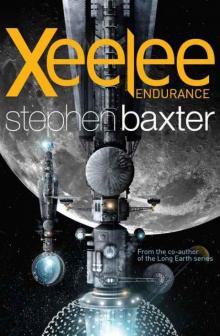 Xeelee: Endurance
Xeelee: Endurance Space m-2
Space m-2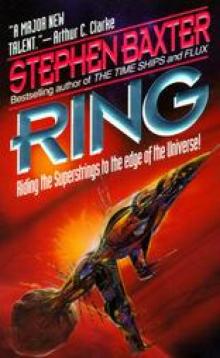 Ring xs-4
Ring xs-4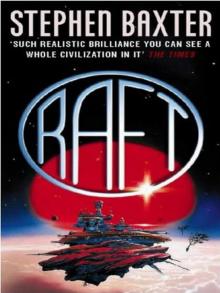 Raft
Raft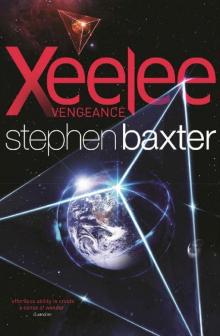 Xeelee: Vengeance
Xeelee: Vengeance Iron Winter n-3
Iron Winter n-3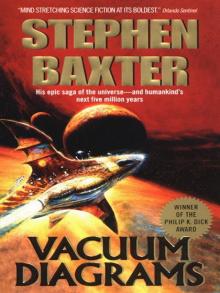 Vacuum Diagrams
Vacuum Diagrams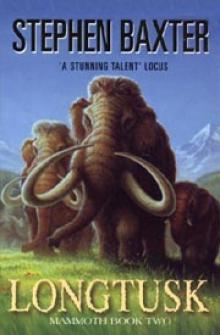 Longtusk tm-2
Longtusk tm-2 Proxima
Proxima Evolution
Evolution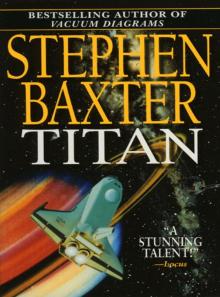 Titan
Titan Last and First Contacts (Imaginings)
Last and First Contacts (Imaginings) Emperor
Emperor The Massacre of Mankind
The Massacre of Mankind Starfall
Starfall Doctor Who - The Wheel of Ice
Doctor Who - The Wheel of Ice Longtusk
Longtusk Silverhair
Silverhair Conqueror tt-2
Conqueror tt-2 Flood
Flood Flood f-1
Flood f-1 Emperor tt-1
Emperor tt-1 Moonseed
Moonseed Conqueror
Conqueror Timelike Infinity xs-2
Timelike Infinity xs-2 The Ghost Pit
The Ghost Pit Xeelee: An Omnibus: Raft, Timelike Infinity, Flux, Ring
Xeelee: An Omnibus: Raft, Timelike Infinity, Flux, Ring Weaver tt-4
Weaver tt-4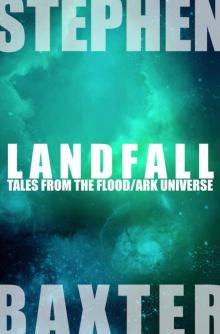 Landfall: Tales From the Flood/Ark Universe
Landfall: Tales From the Flood/Ark Universe Ark
Ark Emperor: Time’s Tapestry Book One
Emperor: Time’s Tapestry Book One Space
Space Icebones
Icebones Manifold: Space
Manifold: Space Navigator
Navigator Obelisk
Obelisk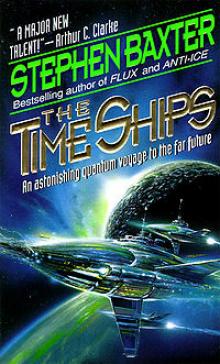 The Time Ships
The Time Ships Bronze Summer
Bronze Summer Resplendent
Resplendent Moonseed n-3
Moonseed n-3 Flux xs-3
Flux xs-3 Transcendent dc-3
Transcendent dc-3 Icebones tm-3
Icebones tm-3 Phase Space
Phase Space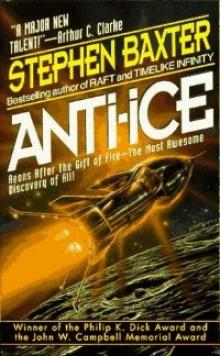 Anti-Ice
Anti-Ice Weaver
Weaver Voyage
Voyage Time m-1
Time m-1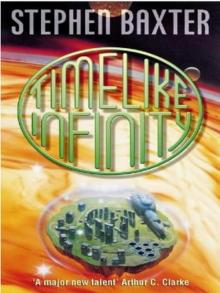 Timelike Infinity
Timelike Infinity Exultant dc-2
Exultant dc-2 Coalescent dc-1
Coalescent dc-1 Navigator tt-3
Navigator tt-3